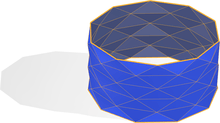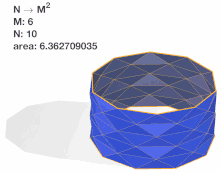Schwarz lantern
The Schwarz lantern is a pathological example of the difficulty of approximating a smooth curved surface with a polyhedron. The curved surface in question is a unit-height axial portion of a unit-radius right circular cylinder. The discrete polyhedral approximation considered has axial "slices". vertices are places radially along each slice at a circumferential distance of from each other. Importantly, the vertices are placed so they shift in phase by with each slice.

Mathematician Hermann Schwarz showed in 1880 that it is not sufficient to simply increase and if we wish for the surface area of the polyhedron to converge to (the surface area of the curved surface).[1] For example, if increases with then the mesh's surface area converges quickly to . If grows faster than then the area can be arbitrarily larger than (including infinite, for example, if increase with ). Thus, the Schwarz lantern demonstrates that simply connecting inscribed vertices is not enough to ensure surface area convergence.

The polyhedral surface bears resemblance to a cylindrical paper lantern.
Notes
- ↑ M. Berger, Geometry I, Springer-Verlag, 1994, p. 263